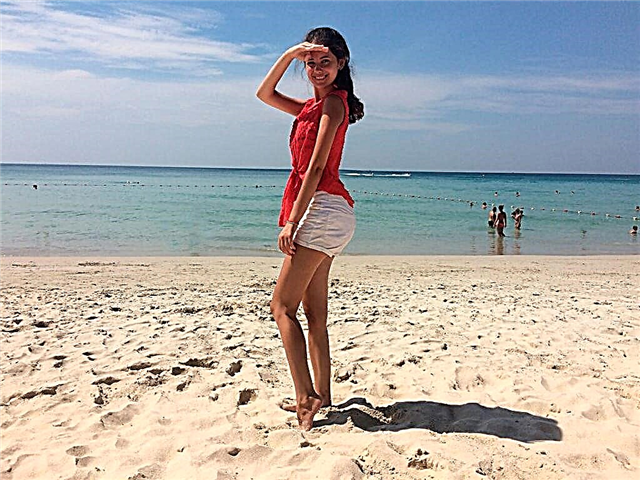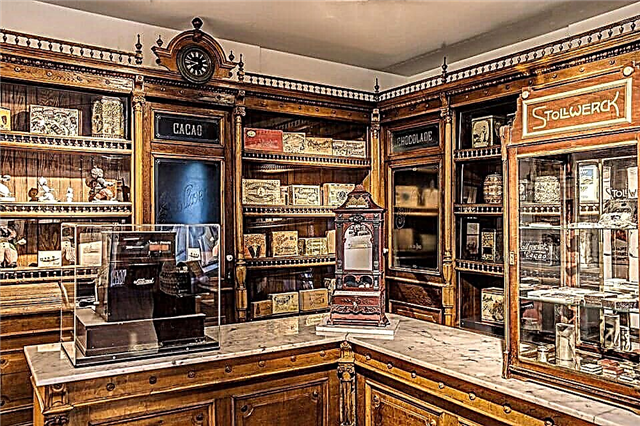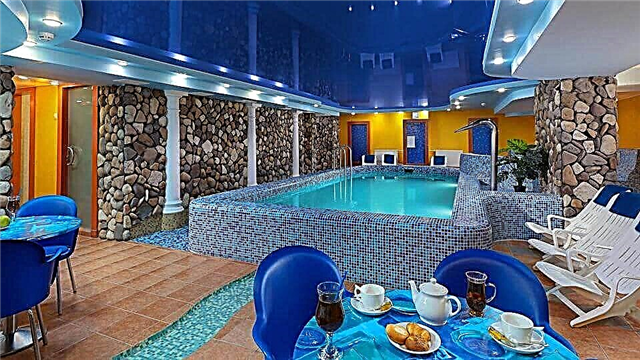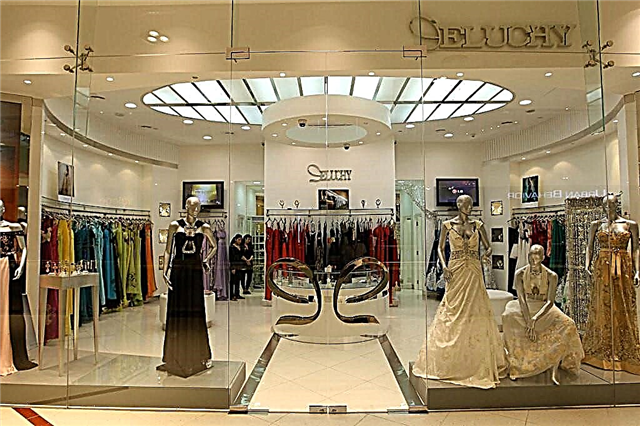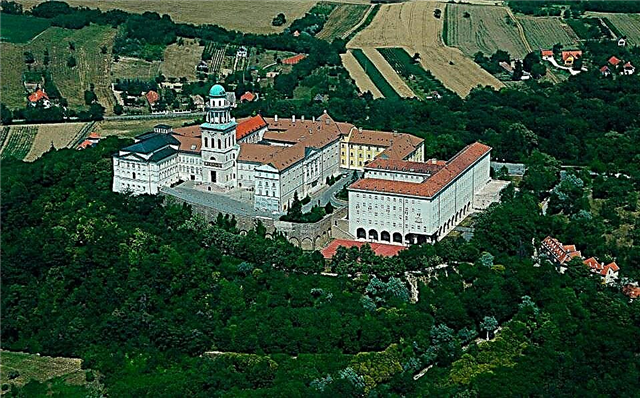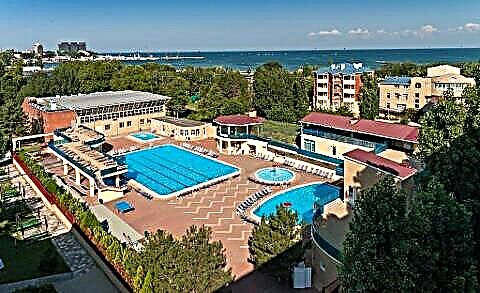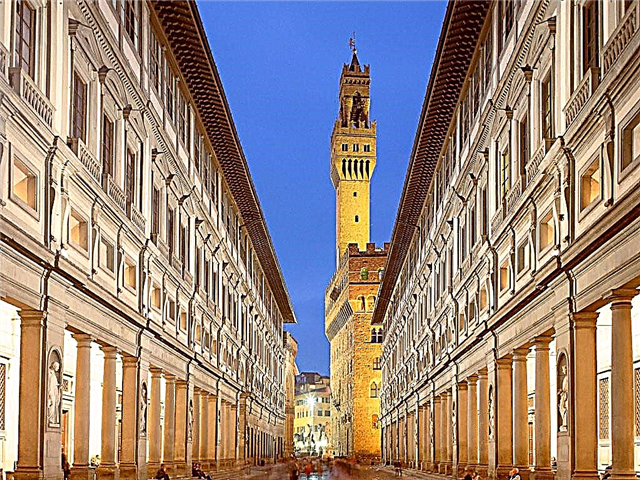Florence first attracts with its beauty and comfort, then penetrates deep into the soul, and then flies in memories and dreams, magically appearing before the eyes. The facades of buildings, the smells and sounds of cobbled streets, the benevolent faces of the indigenous people and the surprised eyes of tourists - everything penetrates into our minds and leaves an “aftertaste”. Travelers and guests of Florence have time to be convinced of its multicolored, eventful life.
History

Florence ("blooming") got its name in ancient times, the foundation of a settlement for the Roman legionnaires-veterans. Nestled among the wide, fertile plains, the city has experienced the brunt of historical events and political unrest that have ever touched Italian soil. Having presented humanity with Leonardo da Vinci and Michelangelo, Galileo and Dante, Florence has earned a special status in the history of world civilization. The Italian literary language originates in the Florentine dialect, the gold florin became the standard of minting European coins, the discovery of the law of perspective is associated with the names of Florentine artists, and the Renaissance owes its origin to the thinkers of Florence.
City-museum, city of attractions. There are really a lot of them here. Every step is another masterpiece. The ancient domes of cathedrals, the majestic facades of buildings, the amazing beauty of the sculptures will not fully reveal their depth to a casual glance, they require slowness and will not tolerate fuss. You just need to walk along the cozy streets of Florence: walk through the same places several times, devote enough time to the city, as far as it will be allowed.

When planning a walking route through the streets of Florence, it is difficult to immediately set aside a certain time to see the historical masterpieces. Somewhere, merging with the crowd of onlookers-tourists, you can manage to proceed at a leisurely pace, without stopping. But at most of the monuments, you want to linger, peer into the details, enjoy the bell chime and plunge into the unique atmosphere of antiquity. Despite the fact that Florence is very convenient for a short trip, you want to either return here repeatedly or stay for a few days. A safe way to get to know the city would be a walk along the old streets, looped in the central, historical part of the city. It is quite possible to complete it in one day. But in this case, it will be necessary to exclude the inspection of the interiors and expositions of museums. If you distribute this route for two or three days, then the impressions will remain deeper and truly tangible.

Florence welcomes guests at all seasons and there is practically no non-tourist season here. First impressions are mixed: medieval streets with crowded facades of buildings, but each private house is loudly called a "palazzo"; unreal blue sky on a sunny day, but motionless ashy dusk in bad weather; endless crowds of tourists and, it seems, no less number of sellers of paintings and souvenirs. But, most importantly, the number of cultural values exceeds all expectations. It is better to start a walk through the old quarters of the city from the administrative center of Florence. For anyone who has ever dreamed of being here, acquaintance with Piazza della Signoria began with postcard views.
Florence: Michelangelo's David Timed Entry Ticket
Florence: Uffizi Gallery Entrance Ticket
Uffizi Gallery Priority Entrance
Florence Cathedral: Dome Entry Ticket
Florence: Palazzo Vecchio Entrance Ticket and Audio Guide
Florence: Hop-on Hop-off Tour. Ticket for 24, 48 or 72 hours
Leonardo da Vinci Museum: Entrance Ticket
Florence: Guided Duomo Tour with Dome Climb
Entrance ticket to the Basilica of San Lorenzo
Hot air balloon ride over Tuscany: Florence
Palazzo Vecchio

The government of the Florentine Republic in 1294 announced the start of construction of the Palazzo dei Signoria, now called Palazzo Vecchio, on the site where a theater existed in ancient times. The main task for the fortress being built was to protect the residence of the priori. Subsequently, over 300 years, many changes and additions were made to the original project. Today Palazzo Vecchio appears before the eyes of a powerful square-shaped building with battlements, a 94-meter clock tower towering over the perimeter of the fortress, and the world-famous sculpture of David Michelangelo (at the entrance there is a copy of the statue).
Having been inside the palace itself, a certain complete picture is formed in the mind: an inner courtyard, a conference room and a salon of five hundred, painted ceilings, marble sculptures and paintings by Italian masters. During the entire existence of the palace, it was the main administrative building of the city. Therefore, in addition to tourists, the local population likes to be here on excursions, and to hold city events. Before visiting Palazzo Vecchio, you should inquire if all the rooms are open to tourists. It so happens that some have already been rented for events and visitors are not allowed there.
Gallery Loggia Lanzi

Loggia Lanzi is 100 meters from Palazzo Vecchio. In the gallery, built in the XIV century, public meetings of the government of the republic were held. Today, first of all, it will attract attention by the number of young artists sitting on the steps. A dozen sculptures are exhibited here, allowing young talents from different countries to gain experience in classical drawing. Everyone is extraordinarily beautiful. But special attention is drawn to the original sculpture "Perseus with the head of Medusa" by Cellini and a copy of "The Rape of the Sabine Women" by Giambologna.
Uffizi Gallery

The building of the Uffizi Gallery was intended for the administrative and clerical work of the city administration, and the Italians, always famous for their special love for art, gradually filled it with paintings and sculptures by modern masters. At first, these were gifts from the personal collections of nobles, then patrons and artists themselves joined them. By the 18th century, there were so many works decorating the gallery that the city administration decided to give this building as a public city museum. Today it is a world famous exhibition area, where 6,000 sq. meters, there are collections of paintings from different schools of Italian painting, antique sculptures and a collection of a unique collection of tapestries.
Bargello Palace

Leaving Piazza della Signoria on Via del Proconsolo, the walking tour will take you past the Bargello Palace. This 13th century building has changed many owners during its existence. It was both a barracks, and a judge's residence, and even a prison. Today it is the National Museum, whose art collection of sculptures is rightfully considered the best in Italy. The galleries and churches of Florence are literally overflowing with works of art. The history of the Renaissance comes to life on the streets here as well. Moving around the city center with narrow, dark streets, it is as if you are in the Middle Ages.
Via Dante Alighieri
Linger on the small Via Dante Alighieri leading to Dante's house. It was here, walking along the pavement as a nine-year-old boy, Dante met the eight-year-old beauty Beatrice, the secret love of his life and the poet's muse. Approaching Piazza Duomo, any traveler begins to feel a certain inner thrill. The desire to get closer to one of the majestic Cathedrals in Europe is very great.
Cathedral of Santa Maria del Fiore

Via del Proconsolo leads to the Cattedrale di Santa Maria del Fiore from the side of the altar, and to see the facade of the temple and the entire ensemble of the cathedral, you need to go around it.The beauty that opens up to the eye is indescribable. The name of the cathedral is “speaking” and in translation it sounds like “Mary magnificent in flowers”. Wall cladding in pearl white, pale pink and matte green marble on the outside makes the cathedral look like an inlaid casket in which it seems that jewelry should be kept. But the interior decoration can partly disappoint with its asceticism and simplicity.
The scale of the Cathedral is grandiose not only in size, but also in the significance of the historical events that took place within its walls. The Florentine rulers passed laws here, Savonarola read his sermons, the execution of Giuliano of the Medici family took place, and the famous author of the dome of the cathedral Brunelleschi and the creator of Campanilla Giotto also found peace. The cathedral ensemble also includes the Baptistery of San Giovanni and Campanila Giotto (bell tower). The oldest baptismal chamber in Florence, octahedral in shape, was decorated with a unique gate by Ghiberti in the 15th century. On ten gilded reliefs of the gates, he depicted the subjects of the Old Testament. After Michelangelo's enthusiastic phrase, they began to be called the "Gates of Paradise".
Via dei Calzaiuoli

From the Duomo, you can head towards the city center along the main street of all times, Via dei Calzaiuoli (street of hosiery and shoemakers). Pilgrims were sent along it through the city to Rome. They were robbed all over the area, and clever Florentines solved the problem of enrichment differently. On this street, they began to sell shoes and sandals to the unfortunate travelers who had knocked their legs off. Florence flourished in the 16th century, when numerous frescoes on street facades turned it into a bright flower. Today only faded shadows remain of these bright petals. But they can still be observed everywhere, on almost every facade of a medieval house.
Palazzo Medici Riccardi

To get to Palazzo Medici Riccardi, you need to walk from the Duomo in the opposite direction from the center. The residence of the most noble Italian family - the first secular building in Florence. But she looks quite ascetic and modest. In those days, the Medici bank office, utility rooms with stables, and the owners' apartments were located here. It will be interesting to be curious about the interiors of the Palace: on some days the Chapel of the Magi with unique frescoes is open to visitors.
Church of San Lorenzo

200 meters from Palazzo Medici, you can admire the Church of San Lorenzo. Located here and crowned with glory, the Medici Chapel was created by Michelangelo in 1520 and was intended to house new burials of the ancient family. The sacristy of the old Medici church already by that time could not accommodate the new tombs.
Santa Maria Novella

Continuing the route along Via del Giglio, in 5 minutes you can already reach the next architectural masterpiece of Santa Maria Novella (di Santa Maria Novella). It was this church that Giovanni Boccaccio chose for the plot scenes in The Decameron. Its lengthy construction, begun in 1246 by the Dominican monks, was completed only in the XIV century. Here you can admire not only the facade of the temple, known from Florentine postcards, but also go to the monastery's green courtyard and the Spanish Chapel.
Palazzo Strozzi

Now, after seeing the sights of the right-bank districts of the old city, you can walk along the famous Florentine bridges. To do this, go down Via del Sole and Via de Tornabuoni. By the way, at the intersection of these streets, you can stop and admire Palazzo Strozzi. This is the palace of another noble family in Florence, the Strozzi clan. In appearance, the building is very similar to the Palazzo Medici, and this is understandable. After all, Strozii has always competed with the Medici. The feeling that the simple facade of the first floor, the high windows of the second and the luxurious courtyard inside the palazzo is not the first time you see it. If there is time, it is interesting to enter the interior of the building. The entourage of the Middle Ages is preserved here authentic to that era: rings for which horses were tied, holders under smoking torches, etc.
Holy Trinity Bridge
To the left bank of the river you can cross the famous Holy Trinity Bridge. The graceful construction of this bridge was invented by Bartolomeo Ammannati, and it was built in the 16th century. Until now, the bridge has suffered many wrecks. But even during this construction, the architect was more concerned not with practical reliability, but with the aesthetic perfection of the building.
Brancacci Chapel and other interesting places

In the city quarters of the left bank of the river, tourists eagerly visit the Brancacci Chapel with its famous frescoes, the Basilica of the Holy Spirit with a church refectory that stores the "Last Supper" of Ghirlandaio and the Palazzo Pitti museum complex.
Ponte Vecchio bridge
Finishing a walking tour of Florence and returning to the administrative center, you need to go from the Otrarno area, famous for small workshops selling their products, to the right bank. This time we will cross the Ponte Vecchio - a bridge that has become popular for photographs of tourist booklets. This bridge has always been socially significant for the Florentines. It was regularly washed away by floods and was regularly rebuilt. In the 15th century, butchers and fish shops were moved here, and trade was allowed only on the old bridge. Waste, however, which was dumped directly into the river, carried the stench for several blocks. Over time, the number of merchants increased, and the bridge expanded in breadth. The outbuildings in which shopkeepers lived have survived to this day.

The nobles of the Medici family, who at that time lived in the Pitti palace on the left bank, could not walk through such a "pigsty" in the Signoria. Therefore, a covered corridor was built for them over the bridge (Vasari Gallery). The traders with the stinking goods were driven out and replaced by jewelers. Many shops on the bridge sell luxurious jewelry and trinkets, and in the evening, at the end of the trade, they close, resembling precious caskets slamming shut. From that moment on, the luxury of exquisite decorations is hidden behind the old wooden frames.
Coming off the bridge, literally after a five-minute walk, it is easy to be at the starting point of our journey. Impressions are in disarray, and the memory is still able to reproduce only sensations: the sounds of the crowd, the voices of the sellers, the melody of the ringing of bells, the creak of the benches in the church, the tantalizing smells of cheese from restaurants and pastries from pizzerias; next to the masterpieces, not candles are burning, but light bulbs, shop windows, the red-brick dome of the Duomo and the pearl robe of a young priest, dazzling with bright colors and the dim light of the streets. All these are the sounds, smells and colors of Florence.
We recommend the following hotels in Florence:
Hotel Spadai
Florence
2 minutes walk from the Cathedral of Santa Maria del Fiore
Superb based on 2,123 reviews

Palazzo Alfieri Residenza D'Epoca
Florence
Located in a historic building in the center of Florence
Superb based on 1,851 reviews

7Florence B&B
Florence
Located in the heart of the city of Florence
Superb based on 402 reviews

Hotel De La Ville
Florence
3 minutes walk from Santa Maria del Fiore
Superb based on 2,302 reviews




